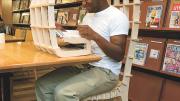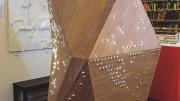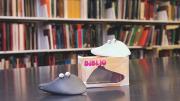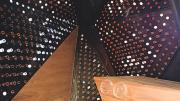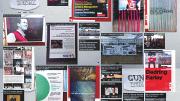“What if you thought seriously about the library as a laboratory, as a place where people do things, where they make things?” asks Jeffrey Schnapp, addressing his “Library Test Kitchen” class. Libraries as centers of knowledge and learning have a rich history—but an uncharted future. The digital revolution, besides changing the nature of books, is transforming the role of libraries in preserving and disseminating information. “What if the Library of Congress were to become a digital library?” continues Schnapp. “What, then, is the role of the physical public library? This is a source of enormous anxiety at the local level because public libraries” face increasing political pressure, including budget cuts, but “play absolutely fundamental civic roles, often as the only public space that remains in smaller communities.”
Last fall, Schnapp, a professor of Romance languages and literatures who is deeply interested in design questions triggered by the digital revolution (see “The Humanities, Digitized” ), teamed up with then Ess professor of law John Palfrey (who chairs the steering committee of the national Digital Public Library of America project), to teach a seminar at the Graduate School of Design (GSD) exploring what form the library of the twenty-first century might take. The seminar was “both an attempt to get the design community interested” in this question, Schnapp says, and to have a “historically informed, design-driven conversation that was in dialogue with Harvard’s big, institution-wide conversation about the reorganization of its own library system” (see “Gutenberg 2.0”.)
The success of the fall seminar—two class-sponsored discussions drew more than a hundred people—led to a renewed incarnation as the “Library Test Kitchen” this spring, a “rapid prototyping studio” at the GSD. During the semester, students designed, built, and deployed novel devices and objects in an attempt to model the library of the future; Schnapp’s co-instructors were Jeff Goldenson of the Harvard Library Lab (which fosters innovation in library services), GSD library director Ann Whiteside, and GSD student Ben Brady, who’d taken the fall class.
In the seminar’s freewheeling atmosphere, ideas flew like cream pies at a food fight. What if behind-the-scenes work could take place in the open instead, suggested Matthew Battles, a fellow at the Berkman Center. “What if you set up somebody processing medieval manuscripts in Widener or Lamont—a processing station in a public space?” Battles had just come from a used-furniture depository, where he’d been scavenging for shelves that could be repurposed for use as curator stations, places where faculty members or librarians could be asked to curate small collections of books. “What about a mobile, inflatable library?” suggested Goldenson. “What would that do?” Or how about an “Artist in Reference,” he continued. “We could bring in experts in a particular subject to serve as guest reference librarians in their area of expertise.” Schnapp, running with the idea, noted that “Widener contains collections in fields that haven’t been taught at Harvard in a hundred years, where we have the best collections of materials.”
By semester’s end, the brainstorming sessions had generated dozens of good ideas, and a few had become student projects: Biblio, a conceptualization of a hand-held device for scanning books that tracks and shares research and even makes bibliographic recommendations for further study (see the online video); Timeslice, a “graphical electronic bulletin board” that lets library users post event announcements to a community calendar that incorporates digital graphics; Neo-Carrel, a study chair with a raised platform in front that doubles as a laptop stand and a comfortable place to rest one’s head for a nap (now installed in Lamont library); and a WiFi cold spot, a radically designed room for reflection or refuge from an increasingly connected world.
“We think this is an opportunity to be real catalysts for thoughtful change that can’t easily come from other quarters,” explains Schnapp. “Because we’re not librarians, but instead a community of artists, scholars, engineers—people interested in knowledge—we come at the questions a little bit differently. So we think we can be innovative and breathe some fresh air into a conversation that often is about how many jobs are going to be cut, or what will happen to all the space that is freed up once the stacks move out to the Harvard Depository. That’s a conversation that may have to happen, but it would be a tragedy if that were the only framework in which we thought about the possibilities for enhancing the mission of libraries.”
